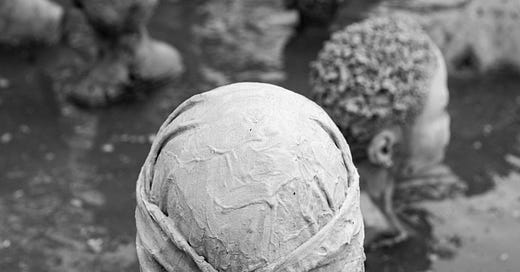
Good morning from… Can you guess where in Africa this is? (Answer at the bottom!)
How France Reigns Over Francophone Africa’s Schoolbooks

When it comes to French-speaking Africa, you might be surprised to learn that France still lords over 85% of the schoolbook market through publishing house Hachette and its subsidiaries, Edicef and Hatier International.
Why? A mix of colonial leftovers, publishing monopolies, and a funding system that puts the real power in the hands of global lenders rather than African governments. The World Bank, the African Development Bank, and bilateral donors foot the bill for most schoolbooks, meaning that African states don’t really get to decide what’s in them—or even where they’re printed. (Spoiler: 80% of these books aren’t even printed in Africa at all.) It also means that competition is skewed, and local industry simply struggles to compete.
Content-wise, the books are tailored to "sub-regions" rather than national histories, a creative decision—or a convenient way to standardize textbooks across multiple countries.
Still, at best, students share one book between three or five classmates, and textbook updates are rare. If this sounds like a broken system, that’s because it is.
The real question is: How can Africa reclaim control of its own educational content? Or will its textbooks continue to be outsourced, financed, and dictated from elsewhere?
A Sculpture Park of Sorrows and Strength: Ghana’s Mesmerizing Memorial to the Enslaved
Amid the sandy paths and soaring bamboo near Ghana’s coastline, you’ll stumble upon a surreal sight: thousands upon thousands of clay heads. Blindfolded, half-braided, masked in silent anguish—each represents an African life stolen into slavery by colonial forces. Welcome to the Nkyinkyim Museum, a stunning artistic love-letter to ancestors who never returned.
At the museum’s heart is Kwame Akoto-Bamfo, artist, activist, and modern-day griot. At one point, he just wanted to sculpt a single clay head. Now he can’t stop; he's aiming for 11,111 of these mournful clay visages. These are personal tributes, some fashioned from family photos Akoto-Bamfo receives from the diaspora, others come from whatever character his creativity conjures up.
Standing next to tall acacia and baobab trees (where local priests often perform blessings), you might see visitors wiping away tears or fuming at a past that still stings. Akoto-Bamfo’s “sweet burden,” as he calls it, is heavy indeed. He’s endured panic attacks from the raw emotions visitors unload on him. Yet he keeps molding, forging each new clay face with the determination of someone who won’t let history’s victims vanish unremembered.
“People cry, get angry,” he says with a gentle shrug. “And I get it.” This museum isn’t about sipping wine in a plush gallery. It’s about grappling with a centuries-old injustice—confronted by the sight of thousands of clay heads, each a soulful reminder: these were once living, breathing individuals, torn from their homes.
Obesity in Africa: The “New HIV” Hitting Women Hardest

Obesity rates are rising so rapidly in Africa that some doctors now compare it to the early days of HIV—complete with stigma, inadequate care, and disproportionate harm to women. According to the World Obesity Federation, nearly half of African women could be overweight or obese by 2030, compared to 26% of men.
Between questionable food marketing, unstoppable fast-food chains, and entire African cities built without so much as a jogging path, many women have found themselves in a perfect storm of carbs and physical inactivity. And then there is the cultural belief in some communities that still see heavier bodies as a sign of wealth.
In the West, celebrities rave about cutting-edge weight-loss jabs, but good luck getting those in sub-Saharan Africa anytime soon. Dr. Chandiwana nearly scored U.S. funding to test semaglutide (a new “miracle” drug) among women with HIV, but that evaporated thanks to politics (the Trump administration froze much research), and so people continue to see obesity as a personal failure – not a disease.
What About Governments? Let’s just say local officials haven’t exactly hoisted the “thin is in” banner yet. Fast-food outlets in many African cities are raking in revenue—and revenue is government catnip. Besides, launching a sugar tax or restricting junk-food ads doesn’t exactly earn politicians points in certain circles.
“We need more prevention, more treatment, specifically targeted at women,” says Chandiwana, who points out that two-thirds of South African women are already overweight or obese.
So What’s Next? While the rest of the world is popping weight-loss jabs and sipping zero-sugar lattes, Africa’s grappling with an ‘epidemic after the epidemic,’ one that’s just getting warmed up. Unless big changes arrive—like serious policy reforms and resource investments—obesity could become the continent’s next major health catastrophe. Because if there’s one lesson from HIV, it’s that pretending a crisis isn’t there rarely ends well.
Food for Thought
“To forget is the same as to throw away.”
— Malawi Proverb
And the Answer is…
The photo is from Lalibela, Ethiopia! Did you guess right?
You can also send in your own photos of Africa, alongside the location, and we’ll do our best to feature them.





A dismal statistic — France still lords over 85% of the schoolbook market in Francophone Africa!
Thanks for sharing!